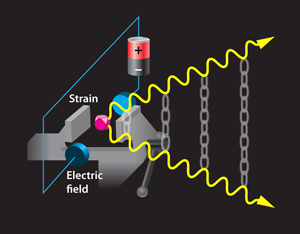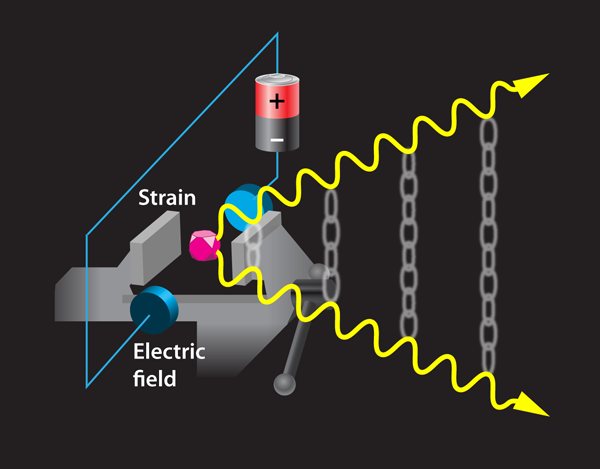Quantum Dots Tuned for Entanglement
Entanglement distinguishes quantum mechanics from classical physics and as such is the core resource in most applications of quantum information science. In previous demonstrations, entangled photons have allowed fundamental tests of quantum mechanics, provided secure communication protocols, enabled computations using algorithms no classical computer could perform efficiently, and provided improvements in optical sensing and imaging [1]. Moving forward, scientists will need reliable, mass-producible sources of entangled photons. Quantum dots are a leading candidate for this role, but these “artificial atoms” suffer from structural irregularities that spoil entanglement by causing a mismatch in the energies of emitted photon pairs. New research in Physical Review Letters [2] overcomes this challenge by using two control knobs—an applied electric field and mechanical strain—that together reshape the electronic structure of the dots so that the possibility for entanglement is recovered.
A pair of entangled photons can be physically separated, but their quantum identities remain locked together. Any measurement of the polarization of one photon, for example, will instantaneously determine the measurement of the corresponding polarization of the other. Today, most experiments employing entangled photons generate them using a weak process of spontaneous frequency conversion in a nonlinear crystal, whereby one parent photon at a given wavelength is converted into two longer-wavelength daughter photons that are entangled. This requires a strong pump-laser intensity and heavy spectral and spatial filtering at the output. If one pumps this process too weakly, then on most attempts no entangled photons result. If one pumps the process too strongly, then too many photon pairs emerge. The statistics of this process provide the most fundamental difficulty in expanding existing photon-entanglement-based quantum information technologies, and these technologies must be scaled up to compete with corresponding classical technologies.
Not all sources of entanglement suffer from these same statistics, however. An atomic cascade process in a single atom, in which two photons result from a single decay, can produce entangled photons with an almost certain guarantee against multiple photon pairs. These processes rely critically on atomic symmetries that leave the emitted photons indistinguishable in all but one degree of freedom, usually polarization. In 2000, Oliver Benson and co-workers [3] pointed out that similar processes could occur in a semiconductor quantum dot. There are many reasons to prefer a semiconductor source of on-demand single pairs of entangled photons, rather than one based on atoms in a trap. Semiconductor fabrication techniques add the convenience of electrical pumping and the scalability of chip-scale integrated optics. Moreover, a single cold microchip could contain large arrays of sources of one-pair-at-a-time entangled photons and could thus replace all the assorted bulky hardware that might otherwise be used in trapped-atom techniques. Unfortunately, the dream of semiconductor-based entangled sources quickly faced a problem: the first attempts at this technology were unable to generate entanglement in photon pairs, due to the lack of atomlike symmetry in real quantum dots [4].
The importance of symmetry stems from the way in which the photons are produced. The process begins by the creation of excitons, which are short-lived bound states between a conduction electron and a valence hole. These states may be optically or electrically pumped, and a state in which a pair of excitons occupies the dot may be selected spectrally. Since these two excitons occupy the same highly confined dot, their lowest energy state has the same spatial wave function and, by the Pauli exclusion principle, opposite spin. When the electrons and holes of the two excitons recombine, the polarization of the photons that are emitted is directly correlated to that spin, resulting in two photons of opposite polarization. If those photons cannot be distinguished by their wavelength, they will be polarization-entangled. However, asymmetries in the quantum dot can change the energy of each single-exciton spin state, resulting in an entanglement-spoiling correlation between each photon’s polarization and its emission wavelength. The energy landscape of an asymmetric dot may also be complicated by couplings between the excitons.
To recover entanglement, one must match the energy of both exciton spin states. Unfortunately, the asymmetries that prevent spin degeneracy in self-assembled InGaAs quantum dots are hard to avoid due to the random, strain-induced process by which they are grown. Researchers have managed in the past to engineer spin degeneracy and subsequent entanglement through a variety of post-growth tuning methods, including adding strain [5], dc magnetic fields [6], dc electric fields [7], and optical fields [8]. Despite these fixes, the dream of large arrays of engineered quantum-dot entanglement sources has so far remained doubtful, in large part because these demonstrated tuning methods only work on a few “hero” dots, namely those whose asymmetry happens to be “just right” for the tuning knob employed.
The advance reported by Rinaldo Trotta of the Leibniz Institute for Solid State and Materials Research, Germany, and his colleagues consists of the application of not just one tuning knob but two [2]. This combination provides sufficiently universal tuning to engineer exciton spin degeneracy in almost any quantum dot. The first knob in this new design is a dc electric field oriented in the dot’s growth direction (illustrated by the battery and metal plates in Fig. 1). The research team achieves this field by growing the dot in a diodelike structure. The second knob is a mechanical strain applied in a direction orthogonal to the dc field (illustrated by the clamp in Fig. 1). This strain is delivered by piezoelectric actuators that are mechanically bonded to the device. The authors describe the basic principle of the device as one knob setting the direction of the entanglement-spoiling perturbation, and the other tuning away the perturbation’s amplitude, so that the two together can eliminate it entirely, regardless of the dot’s detailed structure. To show this, the team closely examined the energies and polarizations of photons emitted from a few different quantum dots as the strain and electric field were varied. They then compared these observations to a simple but adequate theoretical model. Although the experiments did not demonstrate actual entanglement, the results indicated that sufficient degeneracy for creation of entangled photon pairs is attainable. And previous work [5–8] leaves little doubt that such a dual-knob device could produce entanglement.
However, realizing large arrays of on-demand entangled pairs from semiconductor quantum dots still requires more effort. To make efficient sources, the photon emission needs to be limited to a single desired direction, a problem usually addressed by adding a microcavity structure of higher quality than used here by Trotta et al. Many other engineering issues remain to be solved as well, such as controlling quantum dot placement with high yield [9], engineering schemes for electrical pumping [7], and compensating for the highly inhomogeneous character of photons from different devices [10]. Overcoming these hurdles will require continued research by many groups from around the world. But this pursuit of highly efficient and reliable entangled photon sources is worth the effort, since the realization of large entanglement-based technologies for quantum information and measurement applications could be revolutionary.
Acknowledgment
The author would like to thank Charles Santori for valuable discussions.
References
- J. L. O’Brien, A. Furusawa, and J. Vuckovic, “Photonic Quantum Technologies,” Nature Photon. 3, 687 (2009)
- R. Trotta, E. Zallo, C. Ortix, P. Atkinson, J. D. Plumhof, J. van den Brink, A. Rastelli, and O. G. Schmidt, ”Universal Recovery of the Energy-Level Degeneracy of Bright Excitons in InGaAs Quantum Dots without a Structure Symmetry,” Phys. Rev. Lett. 109, 147401 (2012)
- O. Benson, C. Santori, M. Pelton, and Y. Yamamoto, “Regulated and Entangled Photons from a Single Quantum Dot,” Phys. Rev. Lett. 84, 2513 (2000)
- C. Santori, D. Fattal, M. Pelton, G. S. Solomon, and Y. Yamamoto, “Polarization-Correlated Photon Pairs from a Single Quantum Dot,” Phys. Rev. B 66, 045308 (2002)
- C. E. Kuklewicz, R. N. E. Malein, P. M. Petroff, and B. D. Gerardot, “Electro-Elastic Tuning of Single Particles in Individual Self-Assembled Quantum Dots,” Nano Lett. 12, 3761 (2012)
- A. J. Hudson et al., “Coherence of an Entangled Exciton-Photon State,” Phys. Rev. Lett. 99, 266802 (2007)
- A. J. Bennett and et al, “Electric-Field-Induced Coherent Coupling of the Exciton States in a Single Quantum Dot,” Nature Phys. 6, 947 (2010); R. M. Stevenson et al., “Indistinguishable Entangled Photons Generated by a Light-Emitting Diode,” Phys. Rev. Lett. 108, 040503 (2012)
- A. Muller, W. Fang, J. Lawall, and G. S. Solomon, “Creating Polarization-Entangled Photon Pairs from a Semiconductor Quantum Dot Using the Optical Stark Effect,” Phys. Rev. Lett. 103, 217402 (2009)
- C. Schneider et al., “Single Site-Controlled In(Ga)As/GaAs Quantum Dots: Growth, Properties and Device Integration,” Nanotechnology 20, 434012 (2009)
- R. B. Patel et al., “Two-photon Interference of the Emission from Electrically Tunable Remote Quantum Dots,” Nature Photon. 4, 632 (2010); E. B. Flagg et al., “Interference of Single Photons from Two Single Photons from Two Separate Semiconductor Quantum Dots,” Phys. Rev. Lett. 104, 137401 (2010)





